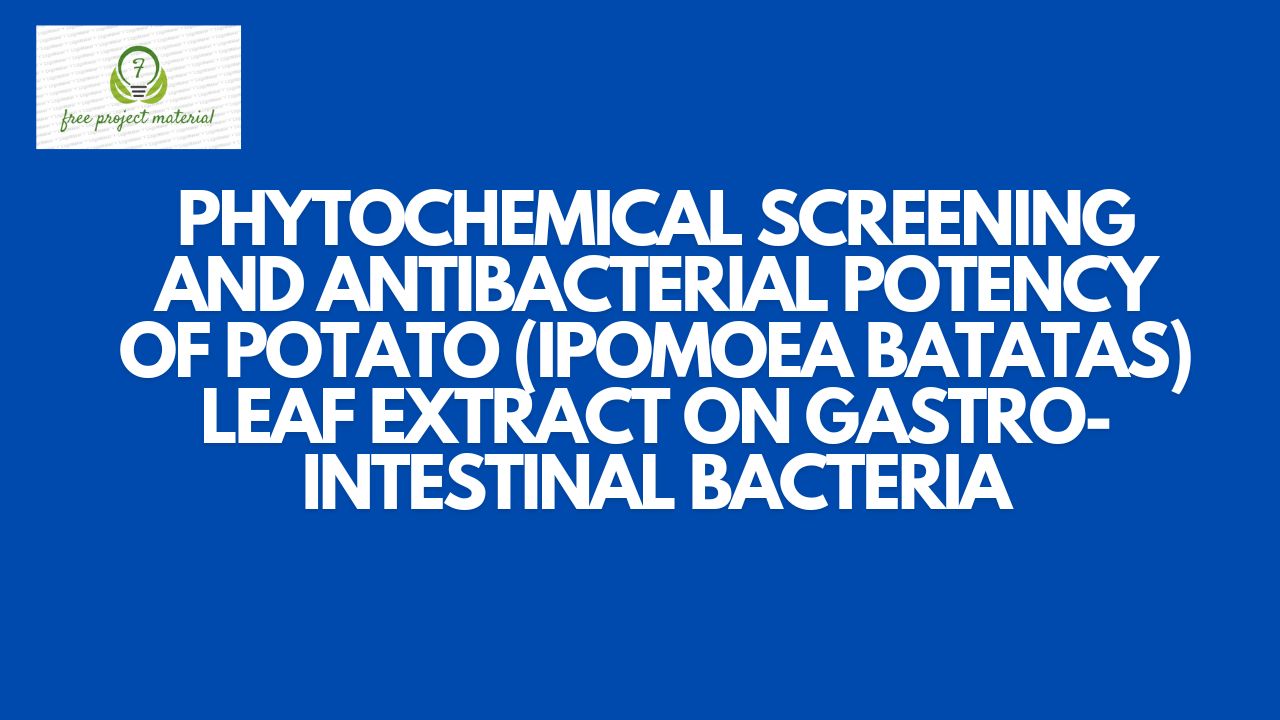ABSTRACT
The aim of this study is to assess the phytochemical composition of sweet potato leaves and to examine the antibacterial activity of the leaves extract against gastro-intestinal bacteria. Standard analytical methods were use for the phytochemical screening and standard aseptical procedures were employed in the antimicrobial analysis. The result of the study revealed the presence of the following phytochemical constituents; Saponins, alkaloids, flavonoids, cyanogenic glycosides, terpenoids, phenol and tannins. The sensitivity test showed that Shigella sp, Escherichia coli, Staphylococcus sp and Salmonella were sensitive to the alcohol leaves extract of sweet potato at higher concentrations ( 100%, 80% and 50%) and were resistant to lower concentration (20%) of the leaves extract. The antimicrobial activity of the leaves extract is attributed to the phytochemical constituents of the plant. Therefore, sweet potato leaves extract should be used for treatment of gastrointestinal infection and should be employed in industries for the production of antibiotic.
TABLE OF CONTENTS
Title Page- – – – – – – – – – i
Certification- – – – – – – – – ii
Dedication- – – – – – – – – – iii
Acknowledgments- – – – – – – – iv
Abstract- – – – – – – – – – v
Table of Content- – – – – – – – – vi-x
CHAPTER ONE: INTRODUCTION
1.1 Background of the Study- – – – – – 1-2
1.2 Aim and Objectives of the Study- – – – – 2
1.3 Scope and Limitation of the Study- – – – – 3
CHAPTER TWO: LITERATURE REVIEW
2.1 Sweet Potatoes Varieties- – – – – – – 4-5
2.1.1 History & Origin of Sweet Potato- – – – – 5-7
2.1.2 Description of Sweet Potatoes- – – – – – 7-8
2.1.3 Taxonomy, Habitat and Cultivation of Ipomoea batatas– – 8-11
2.1.4 Nutritional and Mineral Value of Sweet Potato- – – 11-13
2.1.5 Health Benefits of Sweet Potato and other Uses- – – 13-14
2.1.6 Phytochemical and Biological Activity- – – – 15
2.1.6.1 Anthocyanins – – – – – – – – 15-16
2.1.6.2 Phenolics- – – – – – – – – 16-17
2.1.6.3Triterpenes- – – – – – – – – 17
2.1.6.4 Alkaloids- – – – – – – – – 17-18
2.1.6.5 Phenolic Compounds- – – – – – – 18-19
2.2 Pharmacological and Medicinal Properties of I. batatas– 19-20
2.3 Antimicrobial Properties of I. batatas– – – – – 21-22
2.4 Antioxidant- – – – – – – – – 22-24
2.5 Gastrointestinal Infections- – – – – – 24-25
2.6 Bacterial Pathogens Associated With
Gastrointestinal Infections- – – – – – 25
2.6.1 Shigella Spp- – – – – – – – 25-26
2.6.2 Escherichia Coli O157; H7- – – – – – 26
2.6.3 Salmonella– – – – – – – – – 26-28
2.6.4 Staphylococcus aureus– – – – – – – 28-29
2.7 Signs and Symptoms of Gastro-intestinal Infection- – 29
2.8 Diagnosis, Test and Prevention- – – – – – 30-33
2.9 Antimicrobial Resistance- – – – – – 33-34
CHAPTEER THREE: MATERIALS AND METHODS
3.0 Materials and Methods- – – – – – – 35
3.1 Materials- – – – – – – – – 35
3.2 Methods- – – – – – – – – 35
3.2.1 Sample Collection- – – – – – – 35
3.2.2 Sample Preparation- Leaf extract- – – – – 35-36
3.2.3 Microbiological Analysis- – – – – – 36-37
3.3.1 Sterilization of Materials- – – – – – 38
3.3.2 Preparation of Stock Culture – – – – – – 38
3.3.3 Processing of Clinical Isolates for Isolation or Pathogens – 39
3.3.4 Purification of Isolates- – – – – – – 39
3.3.5 Characteristics and Identification of Isolates- – – – 39
3.4 Susceptibility test of Microbial Isolates of test
Organisms- – – – – – – – – 40
3.4.1 Preparation of Antimicrobial Disk and Inoculation- – – 41
3.4.2 Sensitivity Testing to Determine the Minimum
Inhibitory Concentration (Mic) by both
Dilution Method- – – – – – – – 41
3.4.3 Antibiotic Sensitivity Testing- – – – – – 41
3.5 Phytochemical Screening of I. batatas– – – – 42
CHAPTER FOUR: RESULTS AND DISCUSSION
4.1 Results- – – – – – – – – 43-47
4.2 Discussion- – – – – – – – – 48-52
CHAPTER FIVE: CONCLUSION AND RECOMMEDATIONS
5.1 Conclusion- – – – – – – – – 53
5.2 Recommendations- – – – – – – 53-54
References
LISTS OF TABLES
Table 4.1: Phytochemical Screening of ethanol and aqueous extract of sweet potatoes leaves- – – – – – – – – 45
Table 4.2: Morphological and Biochemical Identification of Bacteria Isolates Obtained from Sweet Potato- – – – – – – 46
Table 4.3: Sensitivity Test of Alcohol Leaves Extract
of Sweet Potato- – – – – – – – – 46
Table 4.4: Antibiotic Susceptibility Test- – – – – 47
CHAPTER ONE: INTRODUCTION
1.1 Background of the Study
Ipomoea batatas (L.) Lam., popularly known as the sweet potato (SP), has played an important role as an energy and a phytochemical source in human nutrition and animal feeding. Sweet potato continues to be of remarkable economic value as the sixth most plentiful food crop in the world (Shih et al., 2009). This tuberous root is a high-quality source of carbohydrates, dietary fiber, vitamin A (as β-carotene), vitamin B6, vitamin C, manganese, copper, potassium, and iron (Dini et al., 2009). Recently studies on sweet potatoes have focused on its antioxidant capacities due to the increased content of phenols, flavonoids, β-carotene, anthocyanins, and caffeoylquinic acid derivatives (Rumbaoa et al., 2009). Other reports have reported its medicinal use, specifically its antidiabetic and antiviral properties (Mitazaki et al., 2005).
Despite the remarkable use of its tuberous roots, there is a lack of detailed data related to the phytochemical composition and biological properties for sweet potato leaves (Islam, 2008). A few studies have performed quantitative analyses for some nutrients and antinutrients from sweet potato leaves. The antinutrient composition was determined by its phytic acid, cyanide, tannins, and total oxalate values (Antia et al., 2006).
1.2 Aims and Objectives of the Study
Aim
The aim of this research project is to determine the antimicrobial potency of sweet potato (Ipoama batatas) leaves extracts on gastro-intestinal bacteria and phytochemical screening of the leaves.
Objectives
To determine the susceptibility of selected bacteria on sweet potatoes leaves extract
To find out the chemical constituents of sweet potato leaves.
To determine the minimum inhibitory concentration of the leaves extract
To make recommendations and suggestion for further studies based on the result obtained from this analysis.
1.3 Scope and Limitation of the Study
The design of this research project is to determined and investigate the antimicrobial potency of potato leaves extract on gastrointestinal bacteria. This is to show if this leaves have any effect on gastrointestinal bacteria like Salmonella, Escherichia coli, Shigella, Staphylococcus aureus. To also screen the phytochemical constituents of the leaves extract due to time and financial constraint.


